ezeedad
57 posts
Nov 23, 2007
3:28 PM

|
I have been told that my birds have the qualmond gene rather than the almond gene.. Is there anyone who can tell from looking at the pictures I am going to post? When I bred 2 of them to each other I also got black selfs and white birds with small flecks.
Also I wanted to post these for Greed for Speed (great name and deadend...
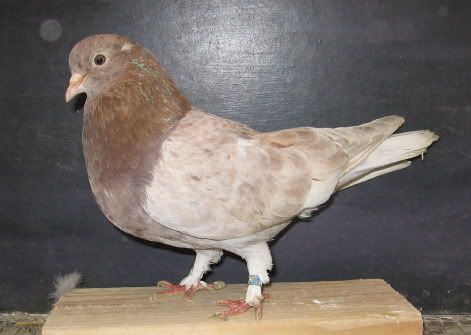
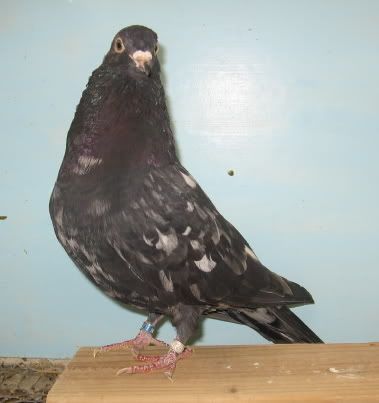
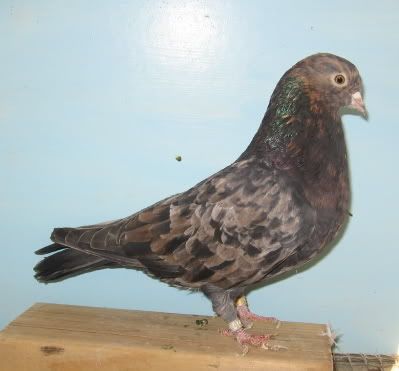
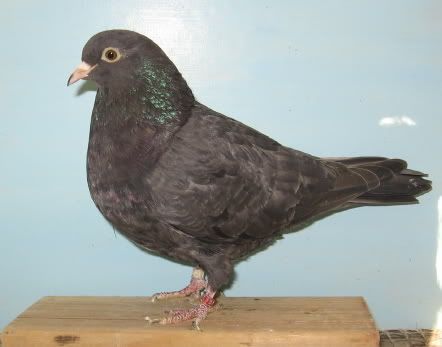
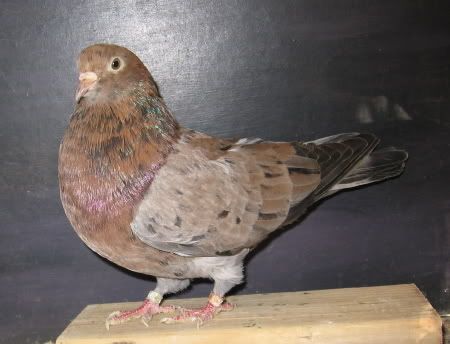
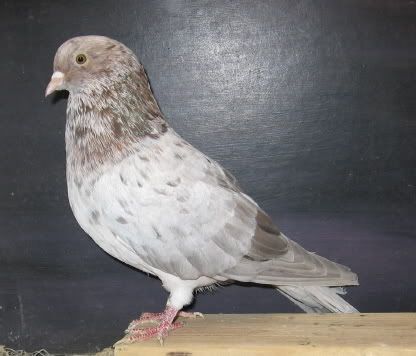
|
gotspin7
568 posts
Nov 23, 2007
3:37 PM

|
qualmond!
|
lionel
42 posts
Nov 23, 2007
3:44 PM

|
Very nice - like 2nd & 3rd pic
----------
Lionel
|
ICEMAN710
46 posts
Nov 23, 2007
4:31 PM

|
I cant help you on the color, but I can surely say they look awesome. great looking birds Paul!
Gary
|
RXR Loft
74 posts
Nov 23, 2007
4:33 PM

|
those are great looking colors..
----------
Rudy
RxR Loft
Roll'em if you got'em...
|
bigwilly
57 posts
Nov 23, 2007
5:37 PM

|
lookin good Paul
|
Donny James
129 posts
Nov 23, 2007
6:05 PM

|
hay ezeedad the 1 3 5 is almonds and the 6vis qualmond and the other 2 i don't know..............donny james
|
Deadendkid
94 posts
Nov 23, 2007
6:08 PM

|
i like those birds dad
|
Ontarioflyer
29 posts
Nov 23, 2007
6:16 PM

|
Hi, paul your birds always look good every
time I see them. Keep up the good work.
Terry
|
J_Star
1323 posts
Nov 23, 2007
6:30 PM

|
Hay Paul, nice looking birds indeed, but where are the jumbo muffs!!! They look naked without them(lol). I can't help you with the difference between Almond and Qualmond there buddy but beautiful birds really. How is their performance? I like #5 the most.
Jay
Last Edited by on Nov 23, 2007 6:30 PM
|
Bluesman
Pigeon Fancier
1173 posts
Nov 23, 2007
6:45 PM

|
I would say they are Qualmond.The second and third pics look like they should be around 6 to 8 years old.Qualmond will get much darker with age just like Almond though.Maybe as Donny said you have both Qualmond and Almond. David
|
luis
336 posts
Nov 23, 2007
8:20 PM

|
I would have to agree with those who said Qualmond.I have 2 old cock birds i bred this past year but lost their offspring to the sky shark.
Great looking group.How do they perform?Here's the pic of 1 of mine.
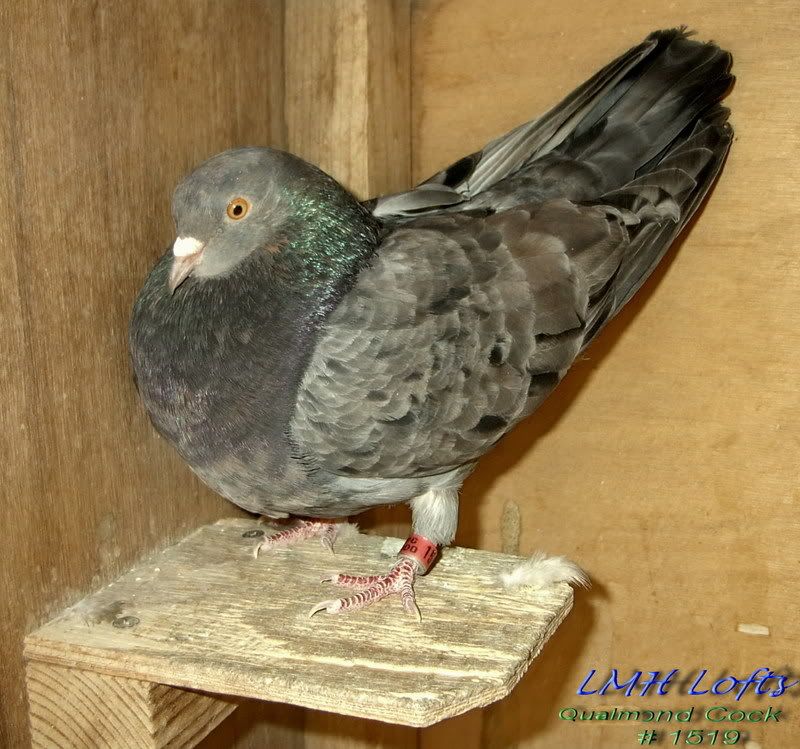 Last Edited by on Nov 23, 2007 8:57 PM
Last Edited by on Nov 23, 2007 8:57 PM
|
elopez
71 posts
Nov 23, 2007
10:42 PM

|
Nice looking birds guys.
|
CSRA
529 posts
Nov 24, 2007
8:43 AM

|
The birds are looking fabulous thats the way i remember your birds
|
donb
35 posts
Nov 24, 2007
4:15 PM

|
Hate to differ with u guys but Luis' bird is the only true Qalmond on the page. The last bird in the series looks like Almond on brown. The Blackish bird could possibly be Qalmond - if so I have never seen one that near black. The others are very typical Almonds. Usually the older they get the darker they get , I have an older almond cock that started out about like the 1 st bird but is now almost black mottle - he is spread also. Usually the bars don't get as dark with age. DB
|
donb
36 posts
Nov 24, 2007
4:18 PM

|
hey guys -- got my numbers crossed, He was more like the 1st bird and is now more like the 2 nd.-- sorry- old age brain LOL. db.
|
Ballrollers
962 posts
Nov 24, 2007
4:27 PM

|
I don't know, Don.......it's really hard to tell without knowing what's behind them......I have a red Qualmond from Turner that is a spittin' image of the fifth one in the series above.
YITS,
Cliff
|
0016
26 posts
Nov 25, 2007
4:54 PM

|
Paul this is Antonio your birds look good.
|
RUDY..ZUPPPPP
555 posts
Nov 25, 2007
5:02 PM

|
Great looking birds guys
|
Gregg
291 posts
Nov 25, 2007
5:32 PM

|
I've kept quiet but you guys are killing me. LOL:>
The almond locus is home to almond, qualmond, hickory, sandy and faded. A good solid kite bronze background gives the best expression of the genes on this locus. But the variability is very widespread on the actual look of the bird. I'm not going to go back and check which ones are almond, but at least one is. What you have to realize is that the same almond gene on a clean blue bar looks quite different than on a t-pattern.
You also have to realize the instability of the gene series. A qualmond is very capable of producing an almond. I have done it many times but it is more difficult to get a qualmond from an almond. The instability is what eventually produced sandy and faded. Lord, please don't make me redo the research to back up this stuff, but if pressed, I can produce same from genetic guru's. Hell, just sit back and appreciate the beautiful birds. Ya gotta love'em Kenny. Spread hickory and spread indigo hickory are very stunning.
I've got to add, smoky, dirty and sooty are also important on the phenotype(the way the birds actually appears) and age continues to darken and deepen the bird's appearance with every molt.
Gregg.
Last Edited by on Nov 25, 2007 5:39 PM
|
ezeedad
74 posts
Nov 25, 2007
6:50 PM

|
Wow..Gregg..!!,
Thank You. You said a lot in a a few words. You must be one of the genetic gurus yourself..!! Basically I've been doing just what you suggest.. just kicking back and enjoying those beautiful colors without worrying about how to produce them.
The colors don't have anything to do with the way the birds roll either.. except maybe they make them better..!! Just kidding... OL' KGB crossed my mind..
A few years I bred one that placed high in the California Classic.. It was a Deroy. Maybe you have another name for that.
So qualmond and almond are different alleles, but they are also different colors? I also thought that the qualmond gene wouldn't produce the bad side effects of the Almond x Almond matings...
I know you don't want to get worked too hard on this subject...sorry you made me curious... Also don't forget I teach high school biology, so I understand genetics basics pretty well.
I'll print out what you said. I believe that I must have the Qualmond and faded genes in my strain.
Gomez
Last Edited by on Jul 26, 2009 9:52 AM
|
donb
41 posts
Nov 26, 2007
2:41 PM

|
Gregg, I know that Almond and faded are on the same chromosome but didn't remember for sure on the Qalmond. I also knoow they are both sex linked dominants--My question is when u get almond and Qalmond in the same bird on the same chromosome what is the phenotye of the bird. I have both almond and qalmonds but they are separate lines and I have never bred them together -- can u post a picture?? thanks, db.
|
Gregg
292 posts
Nov 26, 2007
5:35 PM

|
Paul,
I believe I have your name right. First, my hats off. I do appreciate good teachers. Too bad I didn't have enough of them to keep me motivated.LOL.
DeRoy is nothing more than qualmond, almond or hickory covered by recessive red.
Most homozygous almonds have some moderate to heavy eye problems that run from mild blindness to bulging eyes. One thing that works for me is to mate a qualmond to an almond. The resulting progeny carry both genes and are normal sighted. Just have to keep the flying sharks off their butts. I put an almond on a hickory for the first time this year. Showing more color in little splotches of solid color.
I would venture that you have almond and qualmond. Faded is known as auto-sexing and was heavily used by the old squab producers. The heterozygous males is partially lightened and the homozygous is completely lightened or faded out with a few normal colored feathers on the body. It was easy to sex them as soon as they fledged. The hens are nearly normal colored while the degree of fading determines whether a male is heterozygous or homozygous. By the way, the qualmond gene is named for it's finder, Joe Quinn who happens to be the author of The Pigeon Breeder's Notebook: An Introduction to Pigeon Science. And it should be a book that Tony should carry. Not so subtle hint, hint. DID YOU GET THAT TONY. Joe also found reduced in rollers. Joe's book is without pictures. But it contains all of the important basics of pigeon genetics. I think the price is still under twenty five dollars. It would be a starting place. If you have the Pigeon by Wendell Levi, the genetics in it are authored by the late Dr. Willard F. Hollander. If there was a statue of the late Dr. Hollander, I would have to go there to lay flowers and take a picture of same. He was the most important man in pigeon genetics over the last one hundred years. Sorry for wandering.
Qualmond is a half tone of almonds that does not have enough lightening to give you the base almond coloration.
Don,
Hope the above answers your questions also. No I can't post a picture. I don't like most of the Photo Sharing sites and/or am not enough of a computer geek to handle it. All I need is another place to lose stuff. When Tony makes it possible to directly post pics, then I'll start doing so. Another hinnnnnnnttttttt.
But you should be able mate them together with no problems.
The same rules apply. These are all sex-linked genes. An almond(read qualmond, hickory, faded and/or sandy also) hen will only produce sons of like color whereas a cock can produce sons and daughters. Genetic laws say that you should get an equal number of almonds and non almonds and an equal number of cocks and hens in each category over the long run. But when dealing with only a pair or two, Murphy's laws generally apply. Also, a good kite(bronzed) is the only bird, mated to an almond, that is going to give you the classical almond look. Unless of course you are mating two classical colored birds together in the first place.
Gregg.
P.S. Digest that and more will follow someday. Also some of the credit goes to Dr. Paul Gibson for his encouragement and sharing of information without which I wouldn't know a third of this stuff. I know I'm wandering again, but one has to give credit where credit is due.
Last Edited by on Nov 26, 2007 5:38 PM
|
donb
42 posts
Nov 26, 2007
6:13 PM

|
Gregg, Thanks for the reply. Based on just my own observations the pic posted above by Luis is a typical heterozygous Qalmond cock. My hens look the same if they don't have spread involved. Most homozygous Qalmond cock are very light in color -- almost white. I thought a deroy was simply a recessive red on a typical almond. You forgot to tell me the phenotype of the Almond- Qalmond combination. Does it lean toward one or the other or is it a completely different color??Since they are both dominant and on the same chromosome am curious as to their phenotype Also I havent heard the term " hickory " before. What do they look like. I might have seen them and didn't know it. Thanks for sharing with us. I'm 80 yrs old and have had rollers off and on since 1941 or 42. Been working with a few colors since 1988 and never get too old to learn. DB
|
donb
43 posts
Nov 26, 2007
6:17 PM

|
Hey, guys. While I am on here can anybody tell me why my posts show the words Edit-----------Delete ? they just comeup on my post- don't know why. I guess u can see I'm not too computer oriented LOL. DB.
|
donb
44 posts
Nov 26, 2007
6:17 PM

|
Hey, guys. While I am on here can anybody tell me why my posts show the words Edit-----------Delete ? they just comeup on my post- don't know why. I guess u can see I'm not too computer oriented LOL. DB.
|
J_Star
1350 posts
Nov 26, 2007
6:35 PM

|
So you can edit what you wrote or you can delete your post if you don't want it any more. Click them and see what happens for yourself.
Jay
|
ezeedad
78 posts
Nov 27, 2007
11:11 AM

|
Gregg,
Thanks a lot for your further explanation.. It was another keeper that I printed out to re-read and reabsorb..
Also I was looking online for The Pigeon by Wendell Levi, and I sort of balked at the price.. but now maybe I'll buy it. I'll check first to see if Tony is selling it...another hint....
Paul G
|
Gregg
294 posts
Nov 27, 2007
3:32 PM

|
Don,
Qualmond X Almond will produce both qualmonds and almonds, sex depending on which parent is the male. It will occasionally produce a cock bird that got both, that bird will be very similar to your double factor, homozygous, almond birds. When I want to carry both genes forward on good rolling stock this is the way I do it. I have room for only so many birds and I insist on the performance. So many of my recessive genetic traits are carried forward on what appear to be plain old blue and red checks and bars.
I have been playing with genetics for twenty five plus years, more if you consider the fact that my copy of The Pigeon is about thirty seven years old. I started with just understanding the basics. But it is something that never gets old. Except that this new breed of genetic freaks are all college educated and walk around talking about epigenetics, ie, the affects of our environment(somebody give me a prize, I almost always misspell enviorment?)on the inheritance of and the expression of genetic factors. Then they start on the fact that what we regard as a simple blue bar is simply the result of hundreds to hundreds of thousands of bits of genetic code expressing. They get over my head in a hurry. I am still a big fan of Gregor Mendell. I wonder why?
Gregg.
|
Gregg
295 posts
Nov 27, 2007
3:36 PM

|
Don,
Hickory, check out the fourth picture down, very similar but is not spread as this bird is. The tail will still show color and a tail band or traces of same.
Gregg.
|
donb
45 posts
Nov 27, 2007
7:19 PM

|
Gregg, thanks for the further info. Based on your history with genetics do you think the roll is inherited thru a simple single recessive gene or what is your theory on the inheritance of performance . Thanks, DB.
|
Gregg
296 posts
Nov 28, 2007
5:48 AM

|
There is a core of roller fanciers that believe it is a dominant genetic factor that is and should be controlled to achieve the perfect roller.
Most geneticists use the symbol 'ro' which indicates a recessive gene. I believe that there are a number of genes that are either responsible for and or influence the roll in the Birmingham Roller. Just listen to fanciers talk about their birds and watch same. The variability is awesome. That tends to make the argument for a recessive series of genes. I tend to support that argument given the number of pigeon breeds that were put together to produce the Birmingham Roller.
But one has to also consider the huge variability of dominant genes such as dominant opal. It's phenotypical expression is all over the board to the point that it is at times very difficult to identify.
But cross a good roller with something else and see the results and give the results some thought. They are all likely to do something, but not in any form that we'd want to put in our loft unless you have a large garbage section.
My personal feelings are that the roll is recessive in nature and can be lost by a fancier that has no clue to what the selection process is all about. Just consider the number of good ones that are stocked every year. Not many.
Gregg
|
smoke747
24 posts
Nov 29, 2007
9:57 PM

|
Paul,
these birds look good. Sure would like to see a kit of these fly.
|
kopetsa
733 posts
May 26, 2008
11:14 PM

|
Very nice birds. It is very rare to see so many qualmond almonds at once or whatever you want to call them.
----------
Andrew
|
RUDY..ZUPPPPP
GOLD MEMBER
2705 posts
Jul 25, 2009
5:40 PM

|
.
----------
RUDY PAYEN
PANCHO VILLA LOFT
|
donnie james
605 posts
Jul 25, 2009
10:16 PM

|
hay paul the 1st 3 looks like classic almonds and 4 th one looks a qualmond.............donny james
|
ezeedad
1023 posts
Jul 26, 2009
10:03 AM

|
Hey Donny,
Your guess is as good as mine..!! LOL..!!
Oh and Keith..!! I sure would like to see a kit of them myself..!!
Paul G
|
donnie james
610 posts
Jul 26, 2009
4:40 PM

|
hay paul i'm still learning about myself and he seem to get harder and harder ..............donny james
|